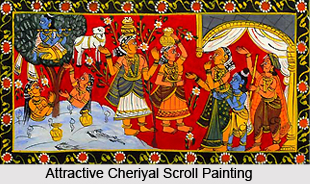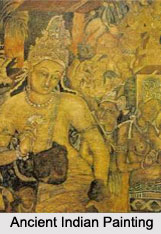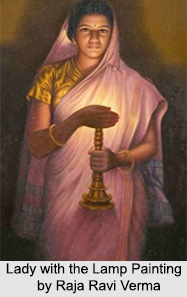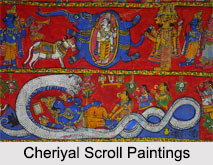 Cheriyal Scroll Painting is a remarkably specialized form of Nakashi art-form practised in Cheriyal village in Warangal District, Andhra Pradesh. These paintings represent the various legends of folklore and mythology, manifested through beautifully painted scrolls containing their narrative formats. Variety of bright hues characterise the Cheriyal scroll paintings, which has been the recipient of the Intellectual Property Rights Protection or Geographical Indication (GI) status in the year 2007. Cheriyal paintings are a unique pictorial presentation of the numerous tales from Hindu epics like Mahabharata and Ramayana and the various Indian Puranas. They acted as wonderful means of communication, particularly useful for illiterate people and conveyed significant moral virtues, motivating people to be virtuous.
Cheriyal Scroll Painting is a remarkably specialized form of Nakashi art-form practised in Cheriyal village in Warangal District, Andhra Pradesh. These paintings represent the various legends of folklore and mythology, manifested through beautifully painted scrolls containing their narrative formats. Variety of bright hues characterise the Cheriyal scroll paintings, which has been the recipient of the Intellectual Property Rights Protection or Geographical Indication (GI) status in the year 2007. Cheriyal paintings are a unique pictorial presentation of the numerous tales from Hindu epics like Mahabharata and Ramayana and the various Indian Puranas. They acted as wonderful means of communication, particularly useful for illiterate people and conveyed significant moral virtues, motivating people to be virtuous.
History of Cheriyal Scroll Paintings
Historical sources have claimed that Cheriyal Scroll Paintings have been introduced to the country by Mughal emperors and initially belonged exclusively to Rajasthan, especially during the 16th century. The `Nakashi` artisans manufactured dolls and painted long tales in scrolls, which were said to be a crucial part of the cultural and sociological culture of Telengana, which constitutes the current-day districts of Kurnool, Mahbubnagar, Medak, Karimnagar and Warangal. Since the paintings are an integral part of the Cheriyal villages, they are termed as `Cheriyal Scrolls`
 Traditional Cheriyal Scroll Paintings
Traditional Cheriyal Scroll Paintings
The traditional art of Cheriyal Scroll Paintings is intrinsically associated to `Kaki Padagollu`, a story-telling community who travelled to different villages, singing verses from the epics or the stories from Indian Puranas, after exhibiting the colour Cheriyal scrolls. Their grand narration was mostly coupled with music and dances. In the ancient ages, Cheriyal Scroll Paintings represented a rare, visual medium while the bard`s song was an impressive audio medium.
The scroll flowed like movie rolls and measured about 40 feet in length and three feet in width, depending upon the kind of tale narrated. The scrolls follow a vertical format which communicates stories along horizontal panels. A building or a tree represents the linear narrative form while a floral border at the centre separates the two panels. Every panel of the Cheriyal Scroll portrayed only a single portion of the story and each scroll consisted of 50 panels. While the bard proceeded on with his tale, the panel speaking about that very part of the story would be exhibited. The iconographic style of every deity was established bearing in mind the particular caste for which the Cheriyal Scroll was made. However, currently a scanty number of artisans are skilled in this technique which had led to a reduction in the availability of such paintings. Singular items for the purpose of wall decorations and banners are the modern products which are employed instead of traditional Cheriyal Scroll Paintings.
Process of Cheriyal Scroll Paintings
Preparation of the canvas for such paintings is a major process. Khadi cotton is effectively treated in a combination of white mud or `suddha mati`, starch which is obtained from rice, gum water and a paste of boiled tamarind seeds. However, the painters must make sure that each coating should be dried properly prior to the application of the next. Thereafter, the outline is sketched over the surface of the canvas using a painting brush and these outlines are generally quite well-defined which depict the skilled craftsmanship of the Cheriyal Scroll painters. Natural hues are employed by the painters. The brushed utilized are made with a stick, tied to the hair of squirrels. The Cheriyal masks are manufactured with the aide of coconut shells and Cheriyal dolls are composed of tamarind paste, wood and saw dust.
Characteristics of Cheriyal Scroll Paintings
Cheriyal Scroll Paintings are extremely beautiful, and the colour red is the main predominant hue painted in the background. One can easily relate to these paintings since they use popular themes, obtained from traditional folklore, mythology and literary accounts. Markandeya Purana, Shiva Purana, Mahabharata, Krishna Lekha, Ramayana and tales of communities like Madiga and Gauda are amongst the important themes. Simple rural lifestyle often finds expression in Cheriyal Scroll Paintings which involve rural festive events, womenfolk engaged in working in paddy fields and also in domestic chores. The garments and attires reflected in the paintings speak volumes about the regional costumes of the inhabitants of Andhra Pradesh, as it is here that they originated.



















